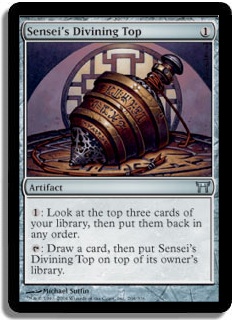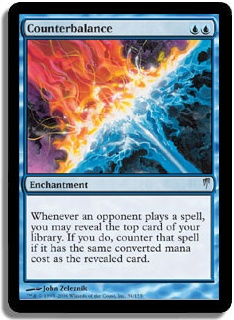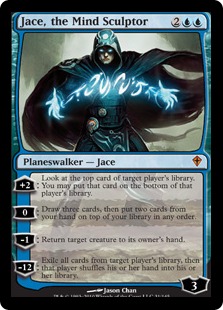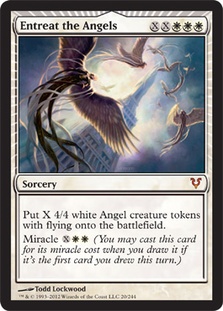As mostly a Magic Online player, I just recently made the transition to paper Magic. Making the switch was relatively smooth since Magic Online forces you to do everything correctly.
Legacy is a wide-open format. Every SCG Legacy Open Top 8 has six or seven different archetypes. I recently piloted a straight CounterTop Control deck to a first place finish at SCG Open Series: New Orleans.
Creatures (4)
Planeswalkers (4)
Lands (23)
- 6 Island
- 2 Plains
- 1 Arid Mesa
- 4 Flooded Strand
- 2 Misty Rainforest
- 2 Scalding Tarn
- 3 Tundra
- 2 Wasteland
- 1 Karakas
Spells (29)
- 4 Sensei’s Divining Top
- 3 Counterbalance
- 1 Detention Sphere
- 4 Brainstorm
- 2 Counterspell
- 4 Force of Will
- 2 Spell Pierce
- 4 Swords to Plowshares
- 2 Entreat the Angels
- 3 Terminus
- 1 Crucible Of Worlds
- 1 Relic of Progenitus
- 1 Counterbalance
- 1 Humility
- 1 Moat
- 1 Rest in Peace
- 1 Disenchant
- 1 Enlightened Tutor
- 1 Spell Pierce
- 3 Geist of Saint Traft
- 1 Vendilion Clique
- 1 Supreme Verdict
- 1 Terminus
Sideboard

CounterTop Control is a very strong deck against a lot of the top decks mostly because of these two cards.
Because the nature of the Legacy format, most cards being played right now have converted mana costs between one and three. So if you have a Top and a Counterbalance out, your opponent will never resolve another spell for the rest of the game.
There are so many decisions to make with Sensei’s Diving Top, especially in the early turns. Arranging the top three correctly to set up the next few turns so you don’t have to Top every turn is very important. Between Stifle and Wasteland, you never know when you’re going to need the extra mana to hold up that Counterspell.
Extra mana is what this deck wants, especially if they are fetchlands. Having fetchland lets you get a fresh look at the top three cards with Sensei’s Diving Top whenever you need to find that crucial two-or three-drop for Counterbalance. The more fetchlands you have out, the worse it is for your opposition. At some point, you’ll be able to set up the top of your deck with two- or three-drops and just float them at the top of your deck to ensure your opponent cannot cast any twos or threes.
Once you’ve assembled Sensei’s Diving Top and Counterbalance to lock your opponent out of the game, you need something to finish the game.
These are the two main win conditions in the deck, although Jace is more reliable in that it is multipurpose. Jace catches you back up when you’re behind. He puts you ahead if you’re on par with your opponent and closes games out in a hurry. There’s nothing sweeter than ultimating a Jace. If they didn’t have an answer for Jace before, they sure don’t have it after they shuffle their hand back into their library. All of Jace’s abilities are very relevant throughout any given game. Between Sensei’s Diving Top and Jace, the Mind Sculptor, the deck gives you so many lines of plays that if you’re not familiar with the deck and what you’re up against, you can easily mess up and lose games you otherwise wouldn’t.
I usually don’t look to win the game with Entreat the Angels because it’s mana intensive and is kind of fragile if you don’t have Force of Will backup. But when the time is right, Entreat the Angels can be pretty powerful. With Sensei’s Diving Top, you can set up and end of turn Entreat to surprise your opponent and put a huge clock on them. It forces your opponent to react differently.
The rest of the cards in the deck are what make this strategy function.
Brainstorm is a staple for any blue deck in Legacy. Not only do you Brainstorm with fetchlands to sculpt the best possible hand, but you can set up miracles and Counterbalance if you don’t have Sensei’s Divining Top out.
Swords to Plowshares is by far the best removal spell for anything that slips past the counters. The life gain from it is mostly irrelevant.
When Swords to Plowshares isn’t enough, there’s Terminus, which is often a one-mana Wrath of God. It help you deals with a ton of Goblins, Zombies from Bridge from Below, and mostly Nimble Mongoose.
Force of Will, Counterspell, and Spell Pierce protect us from most of the unfair things in Legacy as well as help force though our own spells.
Vendilion Clique is great against combo decks. It has flash, so you don’t have to tap out on your turn to cast it. It can take one of your opponent’s key combo pieces and put some pressure on them early so they don’t have all day to set up. It’s also great against the mirror to set up a Jace, the Mind Sculptor or to take a miracle away with the miracle trigger on the stack.
Detention Sphere is just a better Oblivion Ring. The drawback usually doesn’t hurt you because not too many people play Detention Sphere right now. The upside is much more relevant. It’s also an extra blue card to pitch to Force of Will.
I don’t want a lot of Snapcaster Mages because their often just three-mana Brainstorms or Swords to Plowshares. Because I’m not playing any equipment, the body isn’t as important. But having one has been fine.
The one-of Trinket Mage acts as a fifth Sensei’s Divining Top. It also helps search out some of the one-ofs in the sideboard. Honestly, I should have an Engineered Explosives somewhere in the 75 as another target to get with Trinket Mage.
The mana base is pretty standard. You’ve got your usual dual lands, fetchlands, basic lands, and a Karakas. But instead of playing Volcanic Island, I’m playing Wasteland. I was just tired of having so many dual lands against decks with Wasteland, especially RUG Delver. The Volcanic Island started to become a liability, so instead I have Wasteland in its place to help combat the greedy mana of RUG Delver.
The sideboard might look like just a bunch of one-ofs, but every card has its purpose.
There’s a Relic of Progenitus and Rest in Peace for graveyard hate. The extra Terminus and Supreme Verdict are to sweep the board. Humility and Moat are more creature hate. Humility is better against Reanimator type decks whereas Moat is better against Goblins. The extra Counterbalance, Spell Pierce, and Vendilion Clique come in against combo decks. For slower grindy decks when having extra lands is important, we have Crucible of Worlds. It also works well with Wasteland.
Secretly, Enlightened Tutor is the best sideboard card. It doubles each copy of our sideboard cards since it can search out the most important ones even though it’s card disadvantage. The cards you get are usually enchantments, and enchantments are difficult to remove. As such, they often make up the card disadvantage in just a matter of turns if not lock up the game up by themselves.
Abrupt Decay is a card now, but it has yet to make any impact on Legacy. Abrupt Decay is the best card to break up Counterbalance, but I feel like the decks that play it just aren’t very good. I ran into Abrupt Decay once in New Orleans. For that matchup, I planned to board out all my Counterbalances anyway.
CounterTop Control has everything that’s needed to beat almost any deck in Legacy. Counterbalance and Top stop spell-based decks, and Terminus stops creature-based decks. The deck has lots of interaction every turn of the game and really rewards players for making the right plays and knowing the format. I wouldn’t recommend picking up this deck blind, but if you take the time to practice with it, this is a great deck to play at your next SCG Legacy Open.




